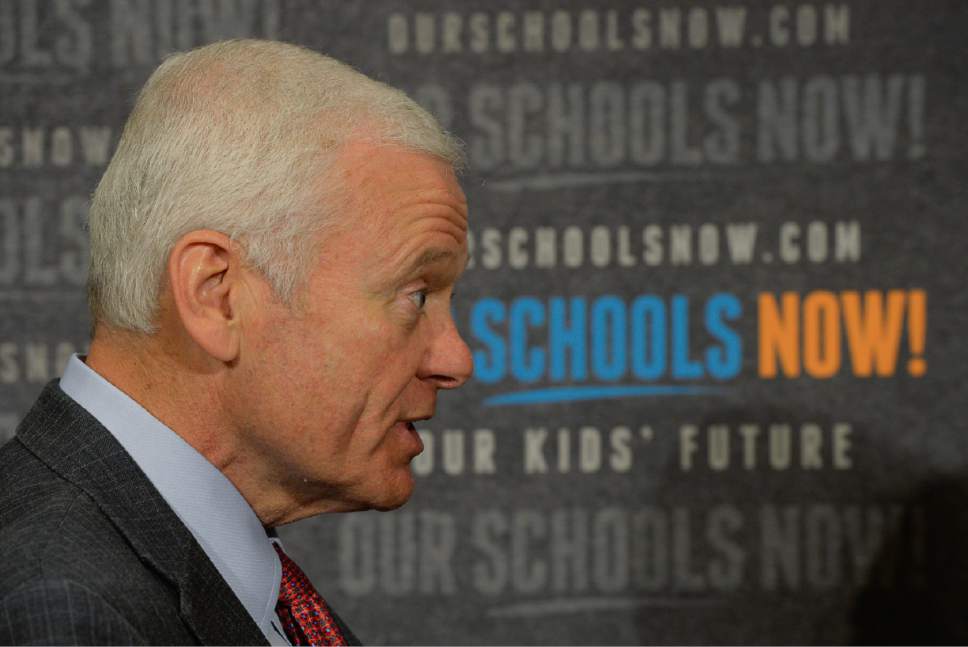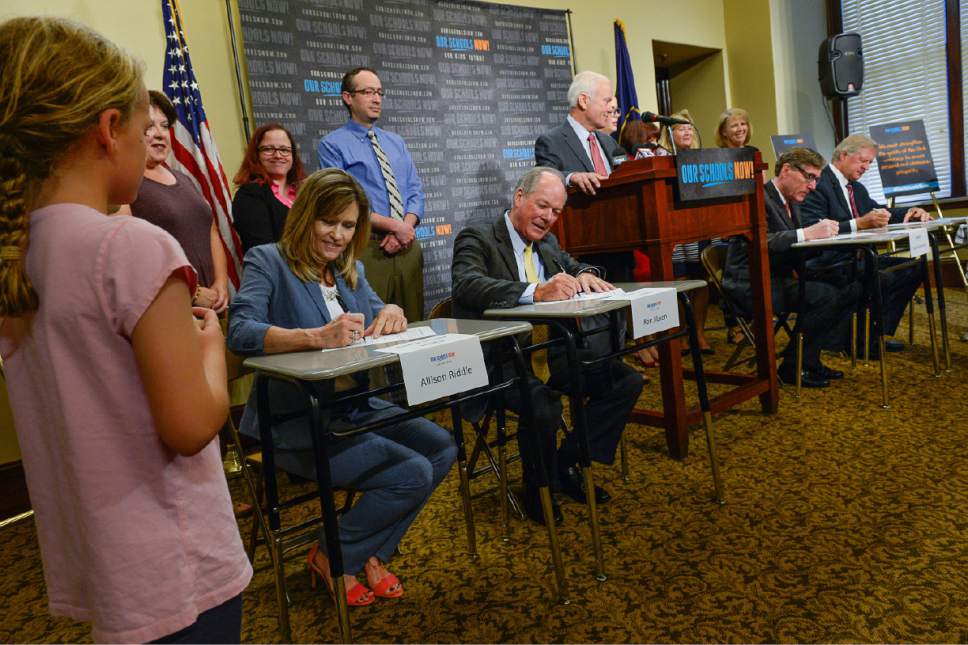This is an archived article that was published on sltrib.com in 2017, and information in the article may be outdated. It is provided only for personal research purposes and may not be reprinted.
The Our Schools Now campaign to boost education funding through tax increases got formally underway on Tuesday — with several notable departures from the group's original plans.
First, backers said the 2018 ballot initiative would seek to raise both sales and income taxes by 0.5 percent, a shift from the income-tax focus telegraphed by Utah business leaders in November.
Second, tax adjustments under the measure would be phased in over three years, Education First chairman Bob Marquardt said, and would net roughly $700 million yearly for public schools, a dip from early estimates.
"We got a lot of encouragement that we should include sales tax," Marquardt said. "Now we raise a little bit less money, $700 million instead of 750 [million dollars]."
The initiative's leaders — a coalition of notable private-sector figures and education community leaders — filed paperwork for the Teacher and Student Success Act with the Utah Lieutenant Governor's office on Tuesday. That filing effectively locks in the details of the initiative, kicking off months of public meetings, signature gathering and campaigning ahead of a public vote in November of 2018. Our Schools Now plans to hold seven information meetings throughout Utah in July, campaign co-chairman Ron Jibson said, with signature gathering expected to begin in August. To qualify for the ballot, the initiative must secure more than 113,000 signatures from residents in at least 26 of Utah's 29 Senate districts.
If approved, the Our Schools Now initiative would lift the state's sales tax rate from 4.7 percent to 4.9 percent in 2019, followed by 5.1 percent in 2020 and 5.2 percent in 2021. For those paying income taxes, Utah's rate would increase from 5 percent to 5.2 percent in 2019, followed by 5.4 percent in 2020 and 5.5 percent in 2021.
The measure is expected to raise an estimated $280 million in the first year of being phased in and $560 million the following year, before reaching $700 million annually in the third year.
According to estimates, the changes would cost the median Utah household $416 in added taxes in 2021, with 52 percent of the total costs borne by the top 20 percent of Utah income earners.
Jibson said that while signature collection will be challenging, he is confident the people of Utah will agree with many in the state's business and education communities that more investment is needed for public schools.
"If we can be successful in collecting these signatures," Jibson said, "we will pass this initiative and will put Utah on a course of generational prosperity."
The campaign's launch met with criticism from anti-tax groups including the Americans for Prosperity and Utah Taxpayers Association, whose representatives questioned the value of boosting school funding without a detailed plan of how money would translate to student success.
"To ask taxpayers for additional money without this type of comprehensive plan in place, and say, 'Trust us' with such a significant amount of increased money is dangerous," Utah Taxpayers Association vice president Billy Hesterman said in a written statement. "More controls need to be in place to ensure that desired student outcomes are achieved and that all Utah students receive a quality education."
Evelyn Everton, director of Utah's chapter of Americans For Prosperity, said Our Schools Now would hurt employment by making the state less attractive to new businesses.
"Utah is held up as the gold standard across the country because we understand that keeping taxes low and doing more with our tax dollars is how the success we've achieved is reached," Everton said. "Other states are trying to emulate what we have, and this goes against the strong principled and foundation we're built on."
Michael Melendez, policy director for the libertarian advocacy group Libertas Institute, accused the Our Schools Now plan of hitting low- and middle-income hardest while distracting from a broader discussion of education reform.
"The corporate elite of Utah have finally decided how they want to reach into taxpayers' pockets," Melendez wrote in a statement, "and, instead of offering any real solutions, they remain committed to the same worn-out, disproven tax hike band-aid."
While the Teacher and Student Success Act does not dictate spending terms to schools, Marquardt said, funding from the tax increases would be contingent on the creation of individual school improvement plans, which would be approved by local school districts.
The Utah Constitution requires that income tax revenue be reserved for public education, while sales tax receipts are subject to legislative appropriations.
Lawmakers boosted education funding by more than $200 million this year without a corresponding tax hike, including a 4 percent bump in per-pupil appropriations.
While Senate and House leaders have largely opposed the Our Schools Now initiative, a proposal to make revenue neutral adjustments to both the sales and income taxes was debated for weeks behind closed doors in the final days of the legislative session, before the talks fell apart.
Marquardt said lawmakers would have the power to change the Teacher and Student Success Act, if it passes, but would face public dissatisfaction for doing so.
"That's pretty hard to believe that if a majority of the people in Utah say we want more money to go to education, that the Legislature would turn around and take it away," he said. "Members of the Legislature have told us they would never do that."
Marquardt also said the name of the initiative was meant to convey the key role that teachers play in quality education, and the need to support Utah's educators through compensation, training, mentoring and classroom support.
"We think that there's nothing more important to the success of education in this state than having a successful teacher in every classroom," said Marquardt.
Several Utah school districts have recently approved salary hikes for educators in an effort to recruit and retain teachers. Experts say Utah is facing a teacher shortage, with more than half of all educators leaving the profession in their first five years and declining enrollment in teaching degree programs.
Utah has also long been ranked last in the nation for the amount it spends on public education on a per-student basis.
"There has never been a more important time to invest in our schools than right now," said Allison Riddle, the 2014 Utah Teacher of the Year.
Scott Anderson, president of Zions Bank and a co-chairman of Our Schools Now, said the additional funding is an economic necessity to prepare Utah's workforce for current and future employment.
"We do not know what the next emerging industry will be here in Utah, but a high quality of education will ensure that Utah students are ready for the opportunities of tomorrow," Anderson said. "Taking Utah's economy to even greater heights begins with increasing the commitment to Utah's teachers and to Utah's students."
Twitter: @bjaminwood









